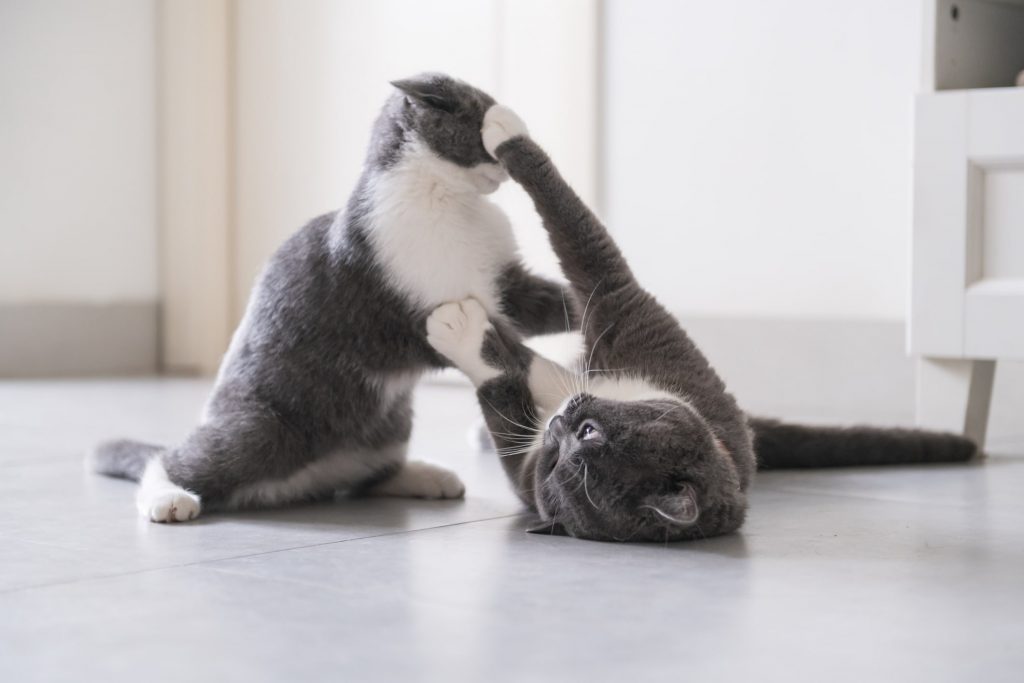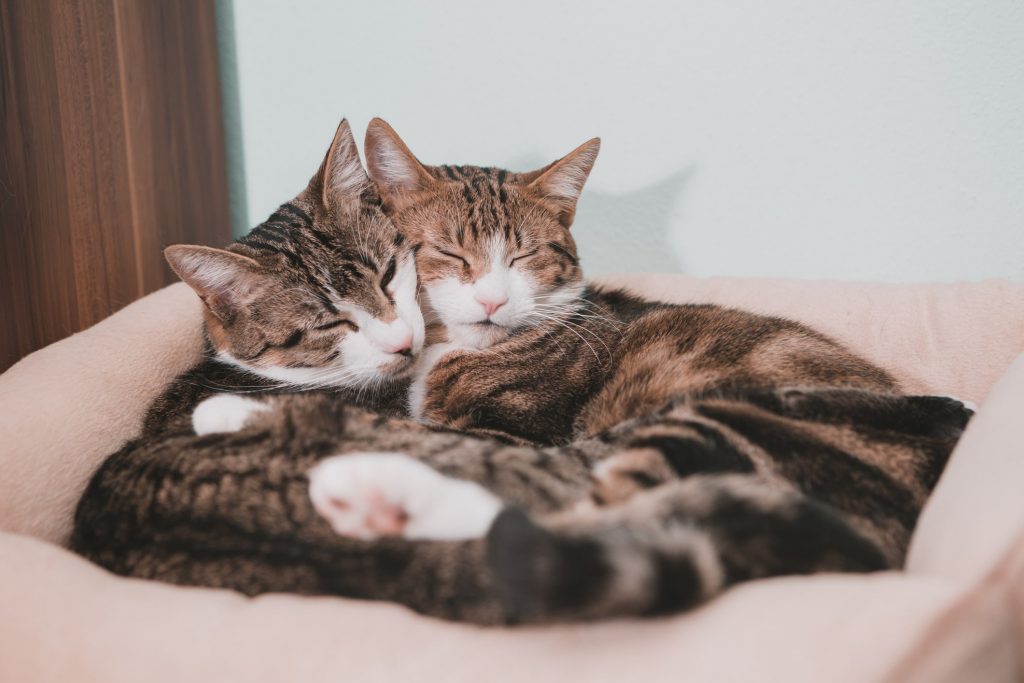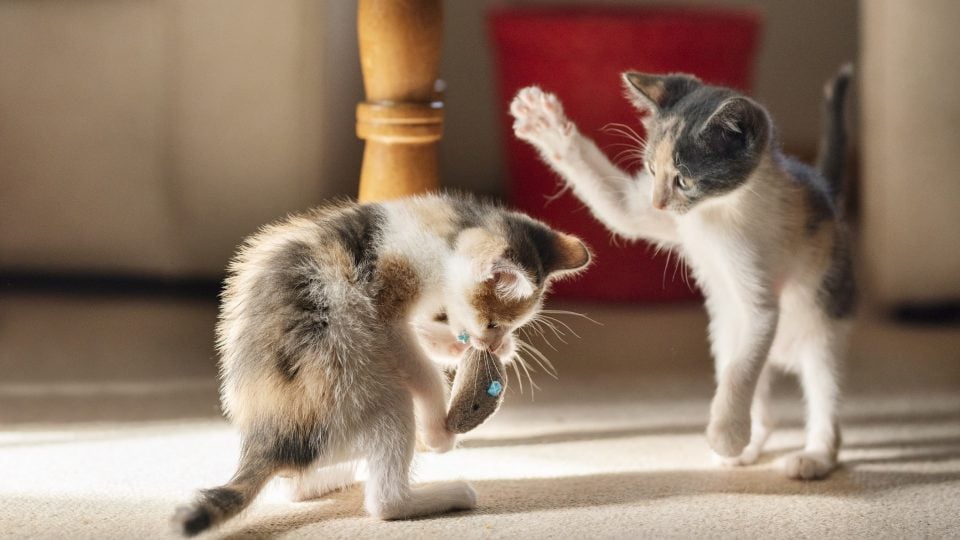If you live in a multi-cat household, chances are you’ve witnessed your cats fighting now and again. Even the best of feline friends can get a little moody, but when the squabbles become all too common, there might be something more going on.
Dr Kat Pankratz, DVM, DACVB, veterinary behaviourist at the Animal Behavior Clinic in Portland, Oregon, USA, guides us through everything you need to know about why your cats are fighting and tips for one big, happy fur family.
Are My Cats Fighting or Playing?
Before trying to figure out why your cats are fighting, it’s important to make sure they aren’t just playing. I’m fostering a three-month-old kitten and more often than not, I can’t tell if everyone is having fun or if my resident cats are trying to chase her out of the house. If you experience the same confusion with your cats, Dr Pankratz says it’s pretty typical. Play is essentially a method of practising aggression in a safe context, she says, so it’s no wonder this can be confusing for human chaperones.
According to Dr Pankratz, there are a few clues that hint at friendly play, and others at fighting:
- Play is balanced. “When one cat is done and walks away, often the other cat respects that cat’s choice,” Dr Pankratz explains. “Fighting is less balanced when one cat continues to pursue the other cat while the other cat attempts to flee.”
- Play is quiet. This one can be tricky because play may or may not come with a plethora of noises. But a few noises that could indicate something more aggressive is hissing, growling, or screaming.
- Fighting could include fur pulling, elimination (urine, stool, anal glands), or other injuries.

chendongshan/iStock
Why Do Cats Fight?
Fighting in cats can be caused by various emotional, physical, or environmental factors. Here’s a breakdown of aggression that could lead to a catfight.
- Redirected aggression. Redirected aggression can occur when your cat has been spooked by another animal, person, or event and is unable to direct his aggression towards that stimulus (if, for example, he doesn’t like the look of something outside the window, beyond his reach). Your cat doesn’t understand what to do with the aggression he feels, so he may take it out on his kitty housemate.
- Non-recognition aggression. Cats rely heavily on their sense of smell, and if their feline roommate smells off—like an unfamiliar cat, person, or place—they may think “intruder!” and react aggressively.
- Territorial aggression. Introducing a new cat to the household can be fun, but your resident kitty (or kitties) might not be as thrilled as you are. Territorial aggression can occur with the addition of another cat, or when resident cats reach social maturity at one to two years of age.
- Inner-cat aggression. This is a hormonal-induced aggression most common in unneutered males, and less commonly, unspayed females.
- Status-induced aggression. According to Cornell University, “cats may occasionally show signs of aggression toward people or other pets when they want to establish social dominance. Cats that block doors with their bodies or swat at other cats as they pass may be demonstrating this type of behaviour.” In other words, your cat is throwing his weight around.
- Play aggression. This article by Cornell University states that cats raised without littermates or who lack other socialisation skills could develop play aggression. “Cats that are about to engage in play aggression will often thrash their tails back and forth, have their ears pinned to the tip of their head, and have dilated pupils. They may stalk their target, whether animal or human, and will often pounce from a hiding place as the target passes by,” researchers write.
My Cats Are Fighting, Should I Stop Them?
Fighting in cats can lead to more than just physical injuries, Dr Pankratz explains. Unlike humans, cats don’t have a lot of ways to repair a relationship once it has been damaged. The social tension caused by prolonged, continuous fighting in kitty housemates could lead to medical and behavioural issues, and an overall diminished quality of life.
This is where you, kitty parent, can step in. At the first sign of tension between your cats, take their attention away from each other to something positive, Dr Pankratz suggests. Reaching for a crinkly bag of treats or opening their favourite can of food could do the trick to diffuse the situation.
If your cats are in the middle of an aggressive fight, it’s best to proceed with caution. Physically placing yourself between your cats could result in serious injury. Instead, Dr Pankratz says: “You may find placing objects between the cats will buy you the opportunity to coax one cat into a separate room. Or, toss a thick blanket over one or both cats, scooping up one cat to place in a separate room for a time.”

w-ings/iStock
How Do I Prevent My Cats From Fighting?
If there seems to be aggression between your floofy housemates, all hope is not lost. “One of the most important recommendations for behavioural treatment plans includes management of the environment to avoid rehearsal of the behaviour,” says Dr Pankratz. Separation can help in isolated situations, but for a long-term solution, Dr Pankratz says to focus on the five pillars of a healthy feline environment, which are:
- providing each cat with a safe place to call their own
- providing multiple ‘key environmental’ resources such as litter boxes, food and water bowls, and scratching and sleeping areas
- offering opportunities for play, scratching, and enrichment
- providing lots of love and positive human interactions
- controlling odours that impact a cat’s sensitive sense of smell
There is no one magical product to stop cats from fighting, but pheromone spray can help to satisfy pillar five (respecting a cat’s sense of smell), Dr Pankratz says. Lastly, Dr Pankratz recommends consulting with a trusted feline veterinary behaviourist.



